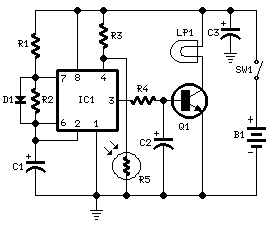Nocturnal Animals Whisker
Source: RED Free Circuit Designs
A low-rate flashing lamp drives away undesired visitors
Automatic on-off operation

Parts:
R1____________100K 1/4W Resistor R2______________2M2 1/4W Resistor R3_____________10K 1/4W Resistor (see Notes) R4______________4K7 1/4W Resistor R5____________Photo resistor (any type, see Notes) C1,C2,C3_______47µF 25V Electrolytic Capacitors D1___________1N4148 75V 150mA Diode IC1____________7555 or TS555CN CMos Timer IC Q1____________BD681 100V 4A NPN Darlington Transistor LP1____________6V 3W Lamp (see Notes) SW1____________SPST Switch B1_____________6V 1.2A Lead acid sealed rechargeable Battery (see Notes)
Device purpose:
This circuit proved very useful in keeping away from a terrace or a porch some bats and other nocturnal animals. You can use it for similar or different purposes. The lamp illuminates at a 4-5 seconds delay and stays off about one minute and 15 seconds. The photo resistor allows automatic switch-on of the circuit at dusk and switch-off at dawn. Supposing an eight hours operation per night, the lamp stays on for a total of about 30 minutes, allowing great current economy.
Circuit operation:
IC1 is wired as an astable multivibrator with on and off time-delays as explained before. R1 & C1 set the on time-delay, R2 & C1 set the off time-delay. As there is no critical parameter, you can set these delays at your wish. Q1 is the lamp driver and can feed rather big lamps. C2 prevents some brief instability when voltage at pin 4 of IC1 is very close to switching threshold.
Notes:
-
Mount the photo resistor's sensitive surface at an angle of 90 degrees or more compared with the lamp, in order to avoid light interaction.
-
Owing to the photo resistor's type or to suit your own special needs, R3 can be varied to set the operating threshold.
-
If you are not needing automatic on-off operation, omit R3 & R5 and connect pin 4 of IC1 to positive supply.
-
The lamp can be any 6V type up to 10-12W, but a 3W one is a very good compromise.
-
Batteries can be of the rechargeable type: lead acid sealed, NI-CD, NI-MH packages ranging from 3.6 to 12V, making sure that suitable lamps are provided.
-
Using 1.2 Ampere-hour batteries, you should probably recharge them once a week or less.
-
Obviously you can feed permanently the circuit by means of a suitable mains power supply.






